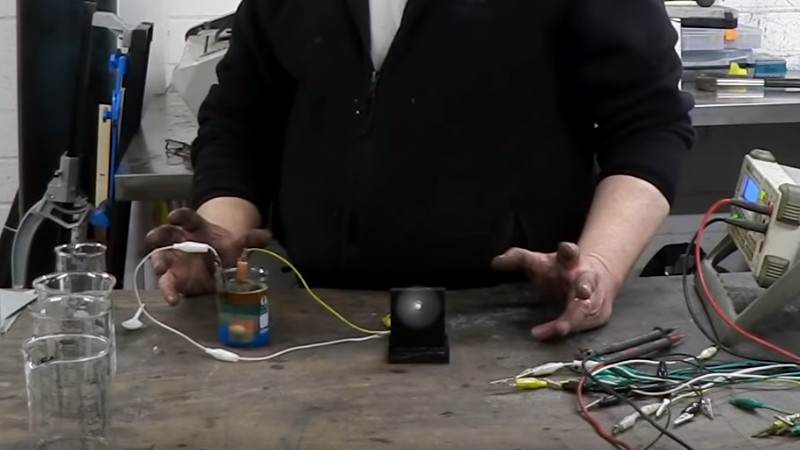The internet is full of dubious content promoting “free energy” devices and other ideas that stretch credibility, so [Robert Murray-Smith] prefaces his demonstration of a gravity battery with a warning to look elsewhere if you are in search of such things. Instead he’s showing us a pair of cells from The Model Engineer and Amateur Electrician, a printed periodical that sounds to us something like an equivalent of Hackaday from the 1890s. (Video embedded below.)
The cells are termed gravity batteries because their constituents settle out into layers not unlike a tequila sunrise under the influence of gravity, something that made them especially suitable for the home constructor in the late 19th century when there were no handy wall outlets from which to snag a bit of power.
The chemistry of each is not unexpected if you spent any time in your high school’s lab, a zinc-copper primary cell with a zinc sulphate/copper sulphate electrolyte and a secondary zinc-carbon cell with a zinc bromide electrolyte and a layer of bromine forming on charging. The construction in large glass vessels is archaic though, and it’s this that’s prompted his video. He poses the question whether this type of cell might be revived using 21st century techniques to produce something of use today. The video is below the break, and even if you are not about to try your hand at electrochemistry it’s an interesting watch.
Thanks [Blaubär] for the tip!
















At the moment, the link is missing.
Thanks!
You forget the link?
https://m.youtube.com/watch?v=p8lyJhk4MjQ
I think you missed the video link
might be this one: https://www.youtube.com/watch?v=p8lyJhk4MjQ
So then, they ought to be called density batteries then?
Grandfather clocks usually have gravity batteries.
That’s the kind I was thinking. Big weight on a pulley connected to some form of generator or escapement. Or use water to make it even more interesting. Was designing a system a while back to use solar to pump water up to a reservoir that would both be used for power by letting it run back down to a lower reservoir through a turbine, or just used to increase water pressure as you’d usually expect a water tower to function. Meant for a friend of mine who lives on a ranch off-grid with a well and lots of sun, but issues with energy storage and enough pumping pressure for irrigation. Basically combining solar with hydroelectric. I’m interested in knowing why it’s apparently not used as often as one might think. Sure makes more sense to me than mining enormous amounts of rare earth metals for lithium batteries, etc.
Pumped Water energy storage in use now. However it isn’t universally transferable. In it’s use today,the turbines that produce electricity, are behind reservoirs that create enough head to operate the turbines, that uses the portion of their output to pump water to reservoir upstream of the powerpant reservoir during off peak hours. The purpose of the upper reservoir is to refill the lower reservoir during peak demand. That’s how I understand the operation anyway. To compare that to your friends water well. While it’s crtainly possible to place ware turbine in the well to create electrical power, such a well needs to be deep enough to provide enough head, to create enough power, be worth the investment. Where the property where well is locatted has enough difference in elevation, that could be advantageous, but will that be financially practical? I ha the great Dve rural property.I also have a bit od a prepper/ survivalist mentality being a generation following two generation a generations that experienced the great depression, and WW II. So yes while I’m not hardcore about it, I have studied what I have control over doing.
The idea of pumping water up to make electricity from the water going down to make electricity to bring more water up is just stupid.
Under many circumstances, you are absolutely correct. HOWEVER, if you–for example–use solar power during the day to pump water up into a reservoir, you can then use the energy that you stored in the water to provide power at night. …and that is smart, not stupid.
Grand father clocks don’t use the sort of battery presented here, have never powered a gcranfathe clock, unless the clock used an electric motor. Clearly you couldn’t bothered to watch the first few moments of the video, or couldn’t comprehend blog write up.
It’s a joke, mate… Grandfather clocks, the weights pull the workings around, as they fall downwards, due to gravity. Then you lift them back up again. Stored energy, replenishable, like a battery, you see? But it works with gravity. That’s the “something different” the title refers to.
Alas, in your attempt to sound smart by belittling someone for their joke, you ended up sounding like a complete fool. Good job.
“easily gotten hold of”
.. there-in lies the rub
If you are like and you don’t have patience to watch a 20 minutes video and wait for the explanation, check the wikipedia link:
https://en.wikipedia.org/wiki/Daniell_cell
Modern day batteries is in the separator due to breakdown or bits of electrodes poking through, so not having to deal with membranes/separators is a good thing.
On the other hand, the surface area vs volume is limited, so these cells will have much higher internal resistance meaning that they can only be used for low currents. Liquids slosh and spill when you move them around.
Our first generation of digital communications were powered by these cells. The telegraph office was quite stationary along the railroad tracks.
My late grandfather years ago gave me an old electrical textbook that had these kind of cells in it.
The line art illustrations in it were great!